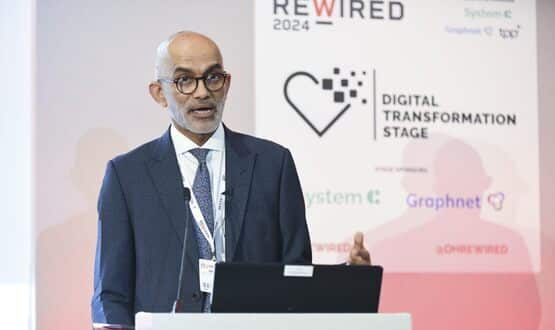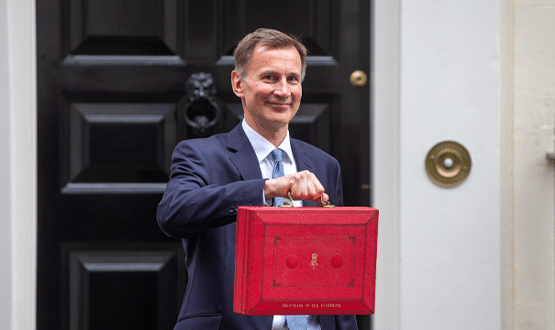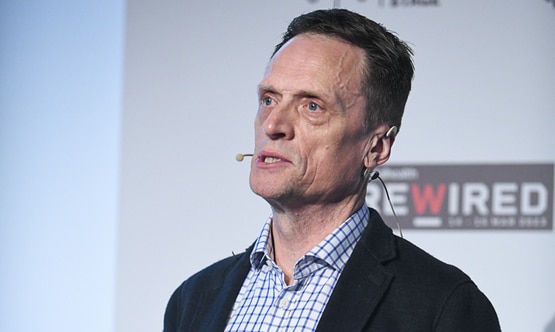Money talks
- 25 June 2012

It is not unusual for the subject of money to come up at the NHS Confederation’s annual conference, but the subject dominated this year’s event in Manchester.
As delegates arrived at GMex, news organisations were running stories about the organisation’s 2012 survey of NHS leaders.
Almost a third (28%) of the 252 respondents described the financial situation facing the NHS as “the worst they had ever experienced”, while another half (46%) said it was “very serious.”
It was a surprise to hear that, a year into the ‘Nicholson challenge’ to the NHS to find £20 billion by 2015-16, 5% of chairs and chief executives thought things were “better” than they had been. But then, it is not as if the NHS is failing to find efficiency savings.
As NHS chief executive Sir David Nicholson outlined in his keynote speech, the health service found £4.3 billion of savings in the year before his challenge kicked in and £5.8 billion last year, while running a surplus of more than £1 billion.
But the savings are not coming from where they need to come from. As Sir David also explained, most have come from national initiatives – including a freeze on wages and a squeeze on management costs – the 4% reduction in the NHS tariff and local cost improvement programmes.
They are not coming from the non-productivity parts of the quality, innovation, productivity and prevention agenda, which was supposed to prevent the ‘salami-slicing’ cuts, rising waiting lists, deteriorating facilities and rationing debates of previous contractions.
Too late for salami-slicing
There are some signs of salami-slicing now. Some 42% of respondents to the NHS leaders’ survey said financial pressures had already affected the experience of patients, while 35% said they had increased waiting times, and 17% said they had affected the availability of treatment and drugs.
Looking ahead, 47% expected the quality of care across the NHS to decline over the coming year. Sir David went further, warning that unless the health service took more radical action, it could find itself dealing with more scandals like the one at Mid Staffordshire NHS Foundation Trust.
Like NHS Confederation trust chief executive Mike Farrar, he said the NHS needed to get to grips with the ‘reconfiguration’ agenda; moving some acute services into specialised centres and moving others into cheaper community settings.
Both admitted that many health communities have had such plans for a decade. But Sir David said it was time to act on them. “We have talked about this for a long time, but the financial position gives us a burning platform to do it this time.”
Both Farrar and Sir David admitted that the NHS would need political backing for the kind of change that will inevitably meaning closing hospitals and other much-loved services.
When pressed on whether this kind of support would be forthcoming, health secretary Andrew Lansley said it would if plans had the support of clinicians, local commissioners and politicians, and would improve services for patients.
As Richard Lewis, a partner at Ernst and Young, noted in a session on service redesign, Lansley’s tests are “a little bit circular”, since they amount to saying that plans will get political backing if they have the backing of politicians.
But in case any of the conference’s delegates thought the keynote speakers were over-stating the scale of the challenge ahead, King’s Fund economist Professor John Appleby spelled out why the financial pressure on the NHS will not ease after 2015-16.
In a session late on Thursday afternoon, he looked at what will happen if the NHS maintains its share of GDP, which has fallen since the financial crisis of 2008.
Even the new Office for Budget Responsibility, which expects economic growth to resume over the next few years, believes that it will take until 2022 for the NHS to get back to where it was in 2008.
In that case, the health service will have £20 billion less to spend than it would have done without the crisis; and it will be £71 billion adrift of what Sir Derek Wanless estimated it would need back in 2002.
Of course, growth could be flat. Or fall. But even if it doesn’t, the NHS would need to make “completely unprecedented” productivity gains of 5% a year for the next eight years to bridge the gap.
Building IT into the efficiency agenda
Technology feeds into this picture in a number of ways. Dr Yi Mien Koh, chief executive of Whittington Health, a new integrated care organisation built around the Whittington Hospital in London, spoke at Lewis’ reconfiguration session.
She said the trust has signed a contract with its “very demanding” commissioners that sets the £280m organisation an £84m “productivity challenge” by 2016-17.
To help to achieve this, it has bought a new IT system from System C, a McKesson company, with £5m of capital support from the Department of Health.
Medway will replace the hospital’s legacy system and the RiO system used by its community staff. Dr Koh said the trust expects to save £1.4m a year as a result, just on medical records handling.
The IT investment will also enable the trust to develop a portal to improve communication with GPs and, eventually, using a model established in Aintree. Dr Koh said that once the portal is in place the trust should save a further £1m a year on sending out letters of various kinds.
Even so, some 60% of the savings will come from reductions in bed numbers and staff, and most of the rest from service redesign.
Whittington Health’s hope is that that the transfer of services from the hospital to the community will eventually level out, and that it will be able to achieve financial stability by running its hospital very “hot” and making a small margin on its community work.
Dr Koh admitted that its financial director “worries” about the simple reduction in income that it has to cope with in the meantime.
IT and transformational change
In a session sponsored by BT on using IT to deliver transformational change, Matthew Swindells, chair of BCS Health, said trusts needed to go further.
“If you look at any other industry that has faced the productivity challenge the NHS faces, it will either have shifted its workforce somewhere cheaper – which is not a practical strategy for a district general hospital – or it will have undertaken a fundamental redesign of its business model, using technology,” he said.
“We have got to start using technology to be disruptive.” He said this would mean using data to analyse and segment the population, and to create new services for people in those different segments, using further technology, such as telehealth.
Mike Farrar, speaking at the same session, not only agreed but said it was “shameful” that some chief executives had welcomed the failure of the National Programme for IT in the NHS “because it meant they did not have to spend money.”
He said the NHS Confederation would be looking to change this mindset, undertaking some practical initiatives to invest in and spread innovation, and working with European politicians to try and protect suppliers that undertake ‘proof of concept’ work with the NHS, so they can commercialise their investment.
In the end, though, he argued that IT really needs “pull factors.” There needs to be a demand for better technology from commissioners, managers and clinicians “so we are no longer happy to make decisions with little or no information.”
There needs to be a recognition that if the NHS does not adopt consumer technologies “we will lose patient satisfaction” and that “if our business delivers a poorer experience than they receive in other aspects of their lives, we will lose patient confidence.”
Getting down to fundamentals
Back at John Appleby’s financial horror session, Nigel Edwards, the former policy director of the NHS Confederation, who now works at KPMG, and Professor Paul Corrigan, a well known analyst and consultant, argued that the NHS needed to go further still.
Edwards said there was plenty of evidence about mergers and cost savings, and all the evidence was that “they never work”, although this did not stop managers trying them in much the same way that Zsa Zsa Gabor tried marriages.
He said the evidence for reconfiguration was “weak”, not least because international evidence suggests that more senior specialists are needed to make new services work – “you need a lot more consultants and you need to pay them 30-40% less; I’ll leave you to decide how likely that is.”
And he said the evidence for population segmentation was “not brilliant”, although it might work if the models improved, it could be done on a bigger scale than the GP practice, and if mental health and elderly care services could be included.
In the end though, Edwards concluded, the NHS would have to ask more fundamental questions about diagnosis and treatment.
“We know that many patients would no choose the treatment they are given, if they had more information about the reality of the treatment and its outcome,” he said. “So if we are not delivering value from what we are doing, perhaps we could think more cleverly about other things that we could do that might deliver value, instead.”
Following on from this, Professor Corrigan argued that the NHS needed to look at “co-production” models. In these, patients create value by doing some of the treatment and support work that the NHS does now, in much the same way that bank users and shoppers create value by doing some of the money transfer and check-out work that tellers and till workers used to do.
Be optimistic. Be very optimistic
This year’s NHS Confederation conference was curiously subdued, as if delegates had absorbed the shock administered by the government’s ‘Liberating the NHS’ reorganisation two years ago, but not yet faced up to the bigger changes ahead.
Sir David Nicholson acknowledged the atmosphere, warning that there was “a fine line between realism and defeatism.”
He tried to get managers to look back at the achievements of the NHS over the past decade, in tackling waiting lists and hospital acquired infections, and improving quality.
“We will make mistakes and success is not guaranteed,” he said. “But we can have confidence in the future. Not blind optimism, but measured optimism, based on what we have achieved.”




